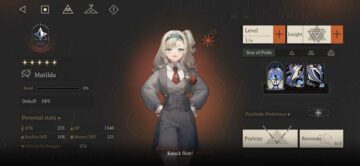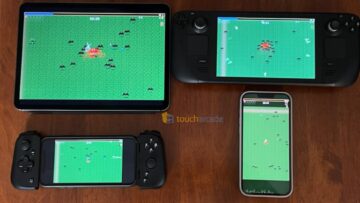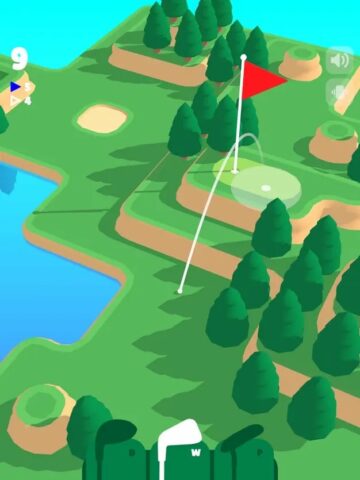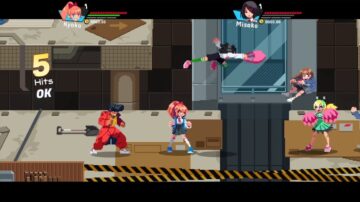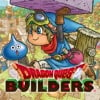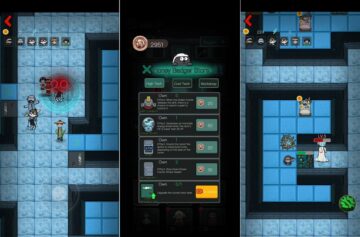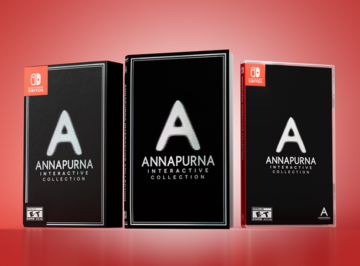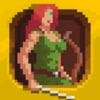 The first game developer who decided to stick a match-3 game and an RPG in a blender sure came up with a tasty juice. Mobile and handheld gamers in particular have enjoyed that concoction for well over a decade at this point, and although we don’t see quite as many of them as we did in their heyday, there’s a certain appeal to them that sees many of us at least trying out anything new that pops up. That said, it’s rare for one to really stand out these days. Like Jared, I initially thought Bright Reappear ($1.99) was just another paint-by-numbers entry into the genre. I was wrong.
The first game developer who decided to stick a match-3 game and an RPG in a blender sure came up with a tasty juice. Mobile and handheld gamers in particular have enjoyed that concoction for well over a decade at this point, and although we don’t see quite as many of them as we did in their heyday, there’s a certain appeal to them that sees many of us at least trying out anything new that pops up. That said, it’s rare for one to really stand out these days. Like Jared, I initially thought Bright Reappear ($1.99) was just another paint-by-numbers entry into the genre. I was wrong.
I don’t think we’re alone in that, though. The screenshots look like any other game of this sort. The description’s English is a bit spotty. The price is quite low. Even when you start playing, it’s not immediately obvious that there’s anything especially cool about it. I’ll be direct here and say the game is absolutely terrible at teaching the player how to play. You just go in and start playing it like it’s a normal duck, matching swords and coins and watching the enemy health go down. But there are mysterious elements in the UI, and unless someone tells you what everything is about you might well play several stages without knowing even about the game’s main hook.
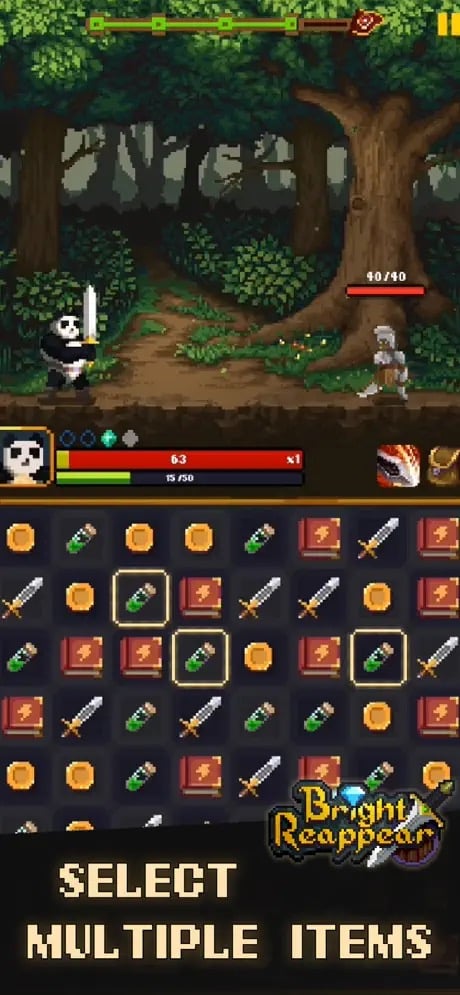 You see, Bright Reappear has one especially compelling mechanic. One that actually gives the genre a good hard shake. You’ll see some little dots in the window with your character and their foe. These are action points. You can make one match per dot on each turn. By default you’ll usually have one dot, so you make one match. But depending on your chosen character and other circumstances, you might have more. Tap the pieces you want to move corresponding to how many dots you have, then move them all with one mighty swipe. They have to move in the same direction, but other than that you can do whatever you like. Building up a bunch of action points and then letting it rain on the enemy is very satisfying. If you’re careful, you can also use these multiple matches to set up big combos. They’re also useful for managing the status ailments that enemies toss at your tiles.
You see, Bright Reappear has one especially compelling mechanic. One that actually gives the genre a good hard shake. You’ll see some little dots in the window with your character and their foe. These are action points. You can make one match per dot on each turn. By default you’ll usually have one dot, so you make one match. But depending on your chosen character and other circumstances, you might have more. Tap the pieces you want to move corresponding to how many dots you have, then move them all with one mighty swipe. They have to move in the same direction, but other than that you can do whatever you like. Building up a bunch of action points and then letting it rain on the enemy is very satisfying. If you’re careful, you can also use these multiple matches to set up big combos. They’re also useful for managing the status ailments that enemies toss at your tiles.
They toss a lot of them, too. There are tons of ways they can mess with your field of tiles, and even defeating an enemy won’t remove the mess they’ve made. You’ll either have to clear them yourself or finish off the boss of the stage. It is really easy for things to get way out of hand, so making careful use of your action points is a must. Matching multiples of pieces works like most other games of this sort, creating pieces that will clear out rows or columns, explode the immediate area around them, or even take out every matching piece on the board. You’ll want to save as many of the big ones as you can for the boss of each level.
The tiles come in four types. The attack tiles look like your chosen character’s weapon and deal damage when you make a match. Green potion tiles restore some of your health when you match them. Coin tiles give you coins, naturally. I’ll explain about those soon, but they work like you would expect. Finally, there are books. Matching them will give you experience points, filling a little bar that sits under your health bar. When it tops off, your health will be refilled and your stats will go up. A well-timed level-up can be the key to getting past some bosses that are giving you trouble, so even managing your experience points gain is part of the strategy.
Leveling up isn’t the only way to improve your character, though. I suppose this is as good a time as any to go into the more RPG-focused bits of the game. First up, you can choose from six different heroes, though only four are initially available. This of course changes your appearance and your starting stats, but the main thing this decision affects is your suite of special moves and abilities. For example, the Thief can hide in the shadows so long as he doesn’t attack, allowing you to rack up matches of the other three tiles practically unscathed. He is absolutely broken. The Archer gets an extra action point every second turn, which is also quite useful. Don’t stress too much about it, you can change whenever and start leveling up a new class if you don’t like your current one, and then switch back later if you prefer.
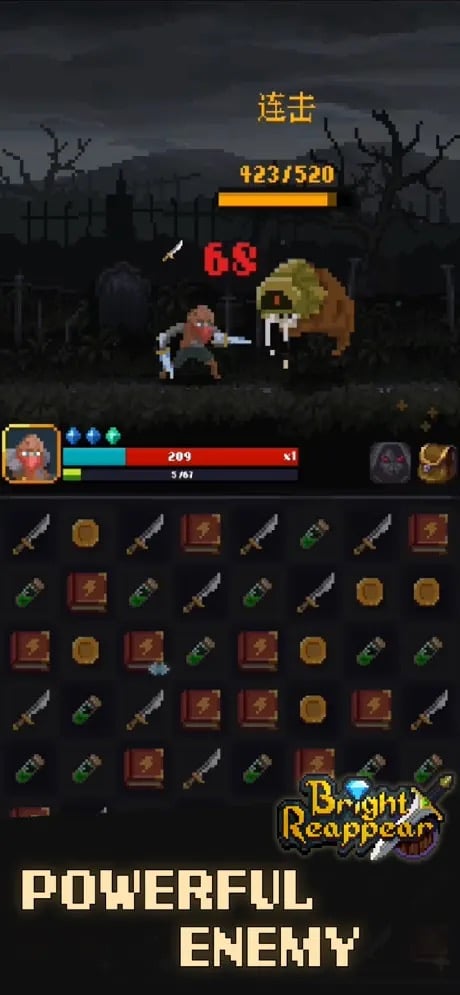 When you level up you’ll earn points that can be assigned to your three stats. By default the game will do this automatically, but you can override it and do it yourself if you like. I advise doing so. Beyond your stats, you can also equip gear. You’ll find that gear when enemies drop it, but there’s also a shop back at your base that will sell a selection of goodies if you have the gold. There is also a blacksmith there who will upgrade your existing gear if you have the gems to fuse to them and the necessary coins. This can fail, but I’m not sure if it’s a bug or a feature. That is not the only part of the game I can say that for, but I suppose more on that later. Anyway, better gear helps. And you’re going to need it.
When you level up you’ll earn points that can be assigned to your three stats. By default the game will do this automatically, but you can override it and do it yourself if you like. I advise doing so. Beyond your stats, you can also equip gear. You’ll find that gear when enemies drop it, but there’s also a shop back at your base that will sell a selection of goodies if you have the gold. There is also a blacksmith there who will upgrade your existing gear if you have the gems to fuse to them and the necessary coins. This can fail, but I’m not sure if it’s a bug or a feature. That is not the only part of the game I can say that for, but I suppose more on that later. Anyway, better gear helps. And you’re going to need it.
Bright Reappear doesn’t have a difficulty curve so much as a difficulty mountain range. A very craggy one, at that. Expect to hit certain bosses that can feel almost impossible, depending on your character and build. The levels of the game are broken up into worlds, with five levels per. The final boss of each world is usually a real nasty piece of work. Thieves keep winning, is all I will say. Otherwise I recommend redistributing your stats and trying to get a level up at the right moment. Tenacity will eventually see you through, even if only by pure luck, but it can take a really long time with some of them. I think it was the fourth world where I was just about ready to throw my device out the window. Well, the first time. It gets a lot worse from there.
Anyway, it’s a neat game. Very fun. The action point gimmick is fantastic, and I find myself trying to come up with really wild chains that simply wouldn’t be possible in other games. It’s hard as an old boot, but that’s fine. I’m in no hurry. The dialogue is goofy because of some iffy localization, but it’s not like other games in the genre don’t suffer from a similar issue. The game looks alright. It could use more music, but I suppose there’s only so much you’re going to commission or compose when most people are going to have the mute switch on. The biggest problem in Bright Reappear, in my opinion, comes from the bugs.
There are times where elements of the UI won’t disappear when they are supposed to. Sometimes fusions will fail and as I mentioned I am not sure if that is intended or not. Once while I was playing the game glitched out and my shop for the Archer turned into the one for the Dwarf, with Chinese language descriptions instead of English ones. I restarted the game and it corrected itself. Sometimes you can still keep playing after your character dies. Just a lot of weird little glitches and bugs all around. Nothing fully show-stopping as far as I’ve found, and I’m very far into the game, but they all add up to make the experience feel a lot less polished than you might hope.
Still, none of that really keeps Bright Reappear down. The action point system adds a whole new dimension to a genre that frankly has gotten a bit stale of late, and I’m happy to be having to use my brain in a new way for a puzzle RPG again. If you enjoy match-3 RPGs and can forgive a healthy sack full of rough edges, I strongly encourage you to check out Bright Reappear. It’s good stuff.
- SEO Powered Content & PR Distribution. Get Amplified Today.
- PlatoData.Network Vertical Generative Ai. Empower Yourself. Access Here.
- PlatoAiStream. Web3 Intelligence. Knowledge Amplified. Access Here.
- PlatoESG. Automotive / EVs, Carbon, CleanTech, Energy, Environment, Solar, Waste Management. Access Here.
- BlockOffsets. Modernizing Environmental Offset Ownership. Access Here.
- Source: https://toucharcade.com/2023/06/26/bright-reappear-review-match-3-rpg-game-mobile-iphone-android/
- $1.99
- 1
- a
- abilities
- About
- absolutely
- Action
- actually
- add
- adds
- advise
- after
- again
- All
- Allowing
- alone
- Alright
- also
- Although
- am
- an
- and
- Another
- any
- Anything
- appeal
- Apple
- ARE
- AREA
- around
- as
- assigned
- At
- automatically
- available
- back
- bar
- base
- BE
- because
- Better
- beyond
- BIG
- Biggest
- Bit
- Blacksmith
- blender
- board
- Books
- both
- Bright
- broken
- buffer
- Bug
- bugs
- build
- Building
- Bunch
- but
- by
- came
- CAN
- certain
- chains
- change
- changes
- character
- chinese
- choose
- chosen
- circumstances
- class
- clear
- Coin
- Coins
- come
- comes
- commission
- compelling
- concoction
- cool
- corrected
- could
- course
- Creating
- Current
- curve
- damage
- days
- deal
- decade
- decided
- decision
- depending
- Developer
- device
- dialogue
- DID
- different
- difficulty
- Dimension
- direct
- direction
- do
- Do It Yourself
- doing
- down
- Drop
- each
- Earn
- easy
- either
- elements
- encourage
- English
- enjoy
- enjoyed
- entry
- especially
- even
- eventually
- Every
- everything
- Example
- existing
- expect
- experience
- explain
- Fail
- far
- Feature
- feel
- field
- filling
- Final
- Finally
- find
- fine
- finish
- First
- first time
- For
- four
- from
- full
- fully
- fun
- gain
- game
- game developer
- Gamers
- Games
- Gaming
- Gear
- Genre
- Get
- getting
- GitHub
- give
- gives
- Giving
- Glitches
- gmail
- go
- going
- Gold
- good
- Green
- hand
- happy
- Hard
- has
- Have
- having
- he
- Health
- helps
- here
- heroes
- Hide
- HIT
- Hook
- hope
- How
- How To
- HTTPS
- i
- if
- IMMEDIATE
- immediately
- impossible
- improve
- in
- initially
- instead
- intended
- into
- Is
- issue
- IT
- itself
- JavaScript
- jpg
- just
- keep
- Key
- language
- late
- later
- least
- left
- less
- Level
- level up
- levels
- like
- Little
- Localization
- Long
- Look
- looks
- lot
- Low
- Luck
- made
- main
- make
- Making
- managing
- many
- Match
- matches
- matching
- Messenger
- might
- mighty
- Mobile
- moment
- more
- most
- Mountain
- move
- much
- multiple
- Music
- must
- my
- Neat
- necessary
- need
- networks
- New
- no
- normal
- not
- nothing
- obvious.
- of
- off
- Old
- on
- once
- One
- ones
- only
- open
- Opinion
- or
- Other
- otherwise
- out
- over
- override
- part
- particular
- Past
- People
- piece
- pieces
- plato
- plato data intelligence
- platodata
- platogaming
- play
- player
- Playing
- Plus
- Point
- Points
- possible
- price
- Problem
- Puzzle
- quite
- range
- Rare
- Rating
- Ready
- Real
- really
- recommend
- remove
- restore
- review
- right
- RPG
- RPGs
- Said
- same
- satisfying
- save
- say
- second
- see
- sees
- selection
- sell
- send
- set
- several
- Share
- Shop
- similar
- Simply
- sits
- SIX
- Skype
- So
- Social
- social networks
- some
- someone
- Sometimes You
- Soon
- special
- Spin
- Stage
- stages
- stand
- start
- Starting
- stats
- Status
- still
- Strategy
- stress
- strongly
- suite
- Switch
- system
- Take
- Tap
- Teaching
- Telegram
- tells
- TenaciTy
- than
- that
- The
- The Game
- their
- Them
- then
- there
- These
- they
- thing
- things
- think
- this
- those
- though
- thought
- three
- Through
- time
- times
- to
- tons
- too
- toss
- turn
- turned
- tweet
- types
- ui
- under
- up
- upgrade
- us
- use
- usually
- very
- via
- want
- was
- watching
- way
- ways
- we
- well
- What
- whatever
- when
- whenever
- where
- while
- WHO
- whole
- wild
- will
- winning
- with
- without
- Work
- works
- world
- Worlds
- worse
- would
- wrong
- you
- your
- yourself
- youtube
- zephyrnet
